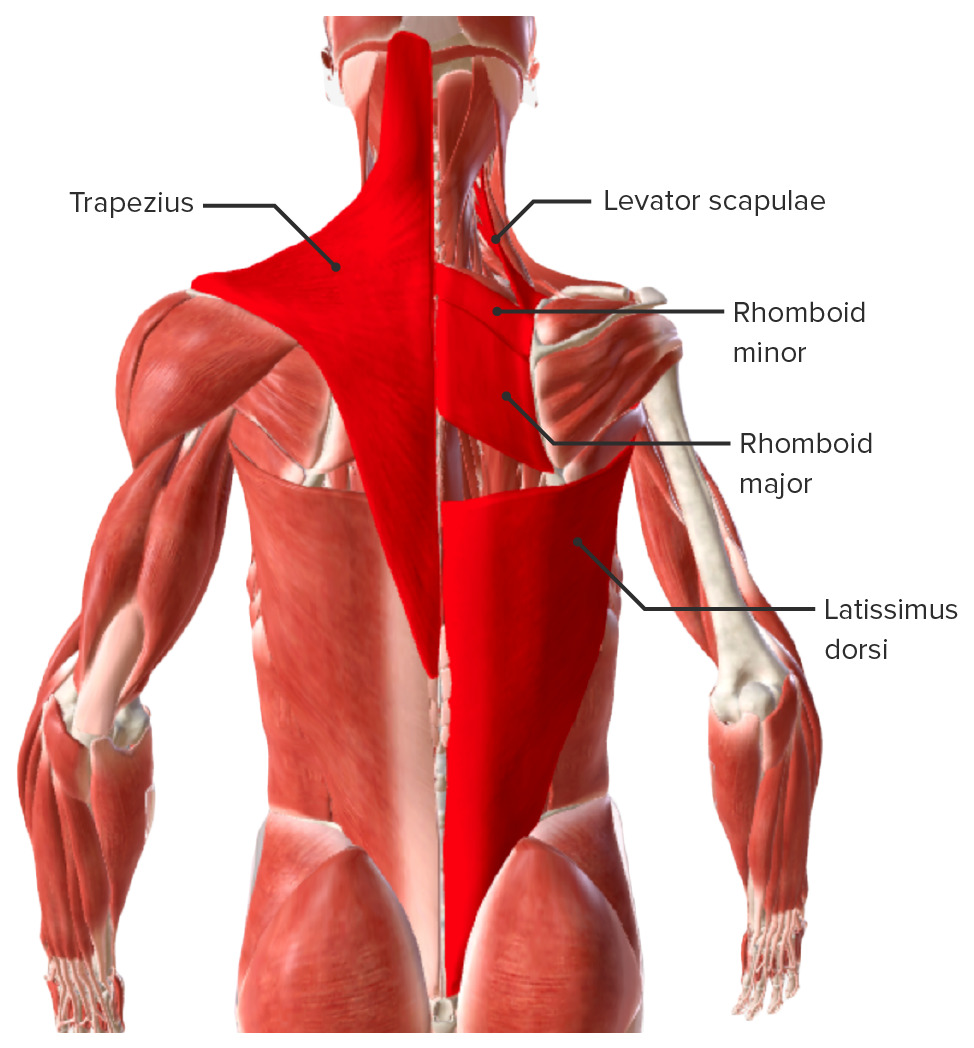Playlist
Show Playlist
Hide Playlist
Superficial and Intermediate Intrinsic Back Muscles
-
Slides Anatomy Superficial Intermediate Intrinsic Back Muscles.pdf
-
Download Lecture Overview
00:01 We'll start with the superficial and intermediate intrinsic back muscles. 00:07 First we have the splenius capitis and splenius cervicis, which together make up the superficial layer, also known as the spinotransversales. 00:18 A little bit further down we have the spinalis, longissimus and iliocostalis which together make up the intermediate layer, or together we call it the erector spinae. 00:33 Here's the splenius capitis. 00:35 A little bit more zoomed in so we can see its attachments. 00:38 We see we have the spinous processes of C7 to T4, going up to the mastoid process of the temporal bone as well as the lateral 1/3 of the superior nuchal line. 00:51 Nuchal meaning muscles that attach to the neck. 00:55 The innervation of this muscle comes from the posterior rami of these middle cervical nerves. 01:03 And its function is together, they'll draw the head backward or posteriorly, but individually, you could have a rotation to one side or the other. 01:14 Just a bit further down we have the splenius cervicis. 01:18 Cervicis meaning cervical relating more to the neck than the head. 01:23 Here we have attachments to the spinous processes of T3 to T6, going up to the transverse processes of C1 to C3. 01:33 Their innervation here is also from the posterior rami of the lower cervical nerves. 01:40 And the function is again together working to cause neck extension, moving the neck somewhat backwards, but individually they can rotate from one side or the other. 01:53 Now let's look at the iliocostalis, which we can see as cervicis, thoracis, and lamborun going from superior to inferior. 02:04 We have attachments all the way down to the pelvic area with the sacrum and the iliac crest. 02:12 And then all along the angles of the lower 6 to 7 ribs. 02:18 And then by the time we get to the thoracic area, we have the angles of the lower 6 ribs, and the angles, the upper six ribs. 02:27 And by time we get to the cervical area, we have the angles of ribs 3 to 6, all the way up to the transverse processes of cervical vertebra C4 to C6. 02:39 Here we see longissimus with a capitis, cervicis, and thoracis referring to head, neck, and thoracic region. 02:48 Here we have attachments to the sacrum, the spinous and transverse processes of the lumbar vertebra all the way up to the lower you know 9 to 10 or so ribs. 03:01 With cervicis, we see we have the transverse processes of the upper 4 thoracic vertebrae going up to the transverse processes of cervical vertebra 2 to 6. 03:13 And then for capitis, we have the articular processes of the lower cervical vertebra going up to the mastoid process of the temporal bone. 03:23 And now the spinalis, which has a cervicis and a thorasis. 03:27 Again referring to cervical area versus thoracic area. 03:32 And here we have attention to the spinous processes of the upper lumbar and lower thoracic vertebra going up to the spinous processes of the upper thoracic vertebra. 03:42 For cervicis, we have the spinous processes of C7 and variably T1 and T2 up to the spinous processes of cervical vertebra 2, also known as the axis. 03:55 The erector spinae altogether, have innovation from the dorsal branches of the cervical and thoracic spinal nerves in that region. 04:05 And the function is that together, they cause back and neck extension. 04:11 But if they're acting individually on one side or the other, they'll cause lateral flexion to the side that's contracting.
About the Lecture
The lecture Superficial and Intermediate Intrinsic Back Muscles by Darren Salmi, MD, MS is from the course Back Anatomy.
Included Quiz Questions
What is the origin of the splenius cervicis?
- Spinous processes T3–T6
- Spinous processes T3–T8
- Spinous processes T1–T6
- Spinous processes T1–T8
- Transverse processes C1–C3
What innervates the erector spinae?
- Dorsal branches of the cervical and thoracic spinal nerves
- Ventral branches of the cervical and thoracic spinal nerves
- Ventral branches of the lumbar and thoracic spinal nerves
- Dorsal branches of the lumbar and thoracic spinal nerves
- Dorsal branches of the sacral spinal nerves
Customer reviews
5,0 of 5 stars
| 5 Stars |
|
5 |
| 4 Stars |
|
0 |
| 3 Stars |
|
0 |
| 2 Stars |
|
0 |
| 1 Star |
|
0 |




